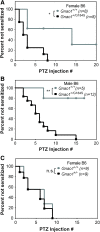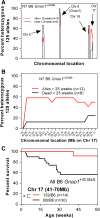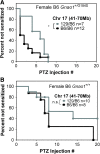Gain-of-function mutation in Gnao1: a murine model of epileptiform encephalopathy (EIEE17)?
- PMID: 24700286
- PMCID: PMC4042023
- DOI: 10.1007/s00335-014-9509-z
Gain-of-function mutation in Gnao1: a murine model of epileptiform encephalopathy (EIEE17)?
Abstract
G protein-coupled receptors strongly modulate neuronal excitability but there has been little evidence for G protein mechanisms in genetic epilepsies. Recently, four patients with epileptic encephalopathy (EIEE17) were found to have mutations in GNAO1, the most abundant G protein in brain, but the mechanism of this effect is not known. The GNAO1 gene product, Gαo, negatively regulates neurotransmitter release. Here, we report a dominant murine model of Gnao1-related seizures and sudden death. We introduced a genomic gain-of-function knock-in mutation (Gnao1 (+/G184S)) that prevents Go turnoff by Regulators of G protein signaling proteins. This results in rare seizures, strain-dependent death between 15 and 40 weeks of age, and a markedly increased frequency of interictal epileptiform discharges. Mutants on a C57BL/6J background also have faster sensitization to pentylenetetrazol (PTZ) kindling. Both premature lethality and PTZ kindling effects are suppressed in the 129SvJ mouse strain. We have mapped a 129S-derived modifier locus on Chromosome 17 (within the region 41-70 MB) as a Modifer of G protein Seizures (Mogs1). Our mouse model suggests a novel gain-of-function mechanism for the newly defined subset of epileptic encephalopathy (EIEE17). Furthermore, it reveals a new epilepsy susceptibility modifier Mogs1 with implications for the complex genetics of human epilepsy as well as sudden death in epilepsy.
Figures





Similar articles
-
Mouse models of GNAO1-associated movement disorder: Allele- and sex-specific differences in phenotypes.PLoS One. 2019 Jan 25;14(1):e0211066. doi: 10.1371/journal.pone.0211066. eCollection 2019. PLoS One. 2019. Retraction in: PLoS One. 2021 Oct 14;16(10):e0258912. doi: 10.1371/journal.pone.0258912. PMID: 30682176 Free PMC article. Retracted.
-
Movement disorder in GNAO1 encephalopathy associated with gain-of-function mutations.Neurology. 2017 Aug 22;89(8):762-770. doi: 10.1212/WNL.0000000000004262. Epub 2017 Jul 26. Neurology. 2017. PMID: 28747448 Free PMC article.
-
A mechanistic review on GNAO1-associated movement disorder.Neurobiol Dis. 2018 Aug;116:131-141. doi: 10.1016/j.nbd.2018.05.005. Epub 2018 May 24. Neurobiol Dis. 2018. PMID: 29758257 Review.
-
Mouse models characterize GNAO1 encephalopathy as a neurodevelopmental disorder leading to motor anomalies: from a severe G203R to a milder C215Y mutation.Acta Neuropathol Commun. 2022 Jan 28;10(1):9. doi: 10.1186/s40478-022-01312-z. Acta Neuropathol Commun. 2022. PMID: 35090564 Free PMC article.
-
Phenotypic Diversity in GNAO1 Patients: A Comprehensive Overview of Variants and Phenotypes.Hum Mutat. 2023 Aug 7;2023:6628283. doi: 10.1155/2023/6628283. eCollection 2023. Hum Mutat. 2023. PMID: 40225165 Free PMC article. Review.
Cited by
-
TALE of an SCN8A-Associated Epileptic Encephalopathy Mouse Model.Epilepsy Curr. 2015 Mar-Apr;15(2):83-4. doi: 10.5698/1535-7597-15.2.83. Epilepsy Curr. 2015. PMID: 26251648 Free PMC article. No abstract available.
-
Clinical Phenotype of De Novo GNAO1 Mutation: Case Report and Review of Literature.Child Neurol Open. 2015 May 5;2(2):2329048X15583717. doi: 10.1177/2329048X15583717. eCollection 2015 Apr-Jun. Child Neurol Open. 2015. PMID: 28503590 Free PMC article.
-
Conditional Disabled-1 Deletion in Mice Alters Hippocampal Neurogenesis and Reduces Seizure Threshold.Front Neurosci. 2016 Feb 25;10:63. doi: 10.3389/fnins.2016.00063. eCollection 2016. Front Neurosci. 2016. PMID: 26941603 Free PMC article.
-
Convulsive seizures and SUDEP in a mouse model of SCN8A epileptic encephalopathy.Hum Mol Genet. 2015 Jan 15;24(2):506-15. doi: 10.1093/hmg/ddu470. Epub 2014 Sep 16. Hum Mol Genet. 2015. PMID: 25227913 Free PMC article.
-
Prioritizing the development of mouse models for childhood brain disorders.Neuropharmacology. 2016 Jan;100:2-16. doi: 10.1016/j.neuropharm.2015.07.029. Epub 2015 Jul 29. Neuropharmacology. 2016. PMID: 26231830 Free PMC article. Review.
References
Publication types
MeSH terms
Substances
Grants and funding
LinkOut - more resources
Full Text Sources
Other Literature Sources
Medical
Molecular Biology Databases
Miscellaneous

